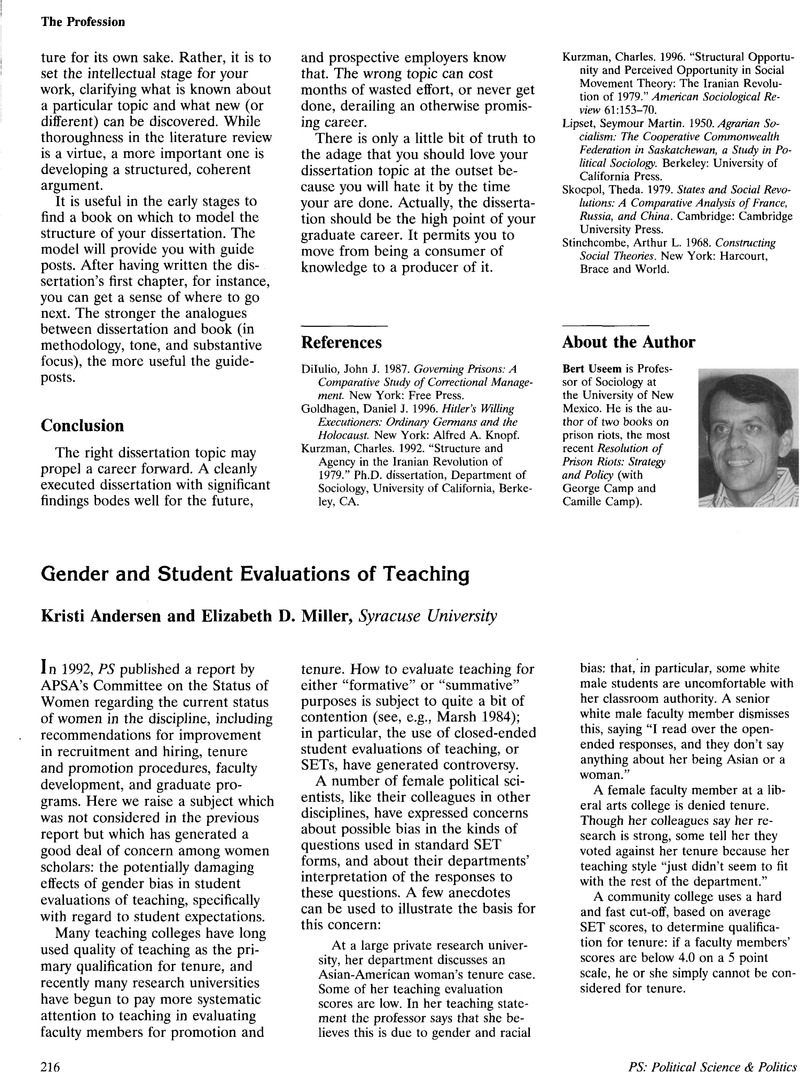Crossref Citations
This article has been cited by the following publications. This list is generated based on data provided by Crossref.
Anonymous
and
Anonymous
1999.
Tenure in a Chilly Climate.
PS: Political Science & Politics,
Vol. 32,
Issue. 1,
p.
91.
Bailey, Charles D.
Gupta, Sanjay
and
Schrader, Richard W.
2000.
Do students’ judgment models of instructor effectiveness differ by course level, course content, or individual instructor?.
Journal of Accounting Education,
Vol. 18,
Issue. 1,
p.
15.
Russ, Travis
Simonds, Cheri
and
Hunt, Stephen
2002.
Coming Out in the Classroom... An Occupational Hazard?: The Influence of Sexual Orientation on Teacher Credibility and Perceived Student Learning.
Communication Education,
Vol. 51,
Issue. 3,
p.
311.
Yunker, Penelope J.
and
Yunker, James A.
2003.
Are Student Evaluations of Teaching Valid? Evidence From an Analytical Business Core Course.
Journal of Education for Business,
Vol. 78,
Issue. 6,
p.
313.
Butler, Daniel M.
and
Christensen, Ray
2003.
Mixing and Matching: The Effect on Student Performance of
Teaching Assistants of the Same Gender.
PS: Political Science & Politics,
Vol. 36,
Issue. 4,
p.
781.
Baldwin, Tamara
and
Blattner, Nancy
2003.
Guarding Against Potential Bias in Student Evaluations: What Every Faculty Member Needs to Know.
College Teaching,
Vol. 51,
Issue. 1,
p.
27.
Ochieng Walumbwa, Fred
Wu, Cindy
and
Ojode, Lucy A.
2004.
Gender and instructional outcomes.
Journal of Management Development,
Vol. 23,
Issue. 2,
p.
124.
Sampaio, Anna
2006.
Women of Color Teaching Political Science: Examining the Intersections of Race, Gender, and Course Material in the Classroom.
PS: Political Science & Politics,
Vol. 39,
Issue. 04,
p.
917.
McPherson, Michael A.
and
Jewell, R. Todd
2007.
Leveling the Playing Field: Should Student Evaluation Scores be Adjusted?*.
Social Science Quarterly,
Vol. 88,
Issue. 3,
p.
868.
Stuber, Jenny M.
Watson, Amanda
Carle, Adam
and
Staggs, Kristin
2009.
Gender expectations and on-line evaluations of teaching: evidence from RateMyProfessors.com.
Teaching in Higher Education,
Vol. 14,
Issue. 4,
p.
387.
Potvin, Geoff
Hazari, Zahra
Tai, Robert H.
and
Sadler, Philip M.
2009.
Unraveling bias from student evaluations of their high school science teachers.
Science Education,
Vol. 93,
Issue. 5,
p.
827.
Bingham, Robin
2009.
Women’s Experiences in Leadership in K-16 Science Education Communities.
p.
63.
Carle, Adam C.
2009.
Evaluating college students’ evaluations of a professor’s teaching effectiveness across time and instruction mode (online vs. face-to-face) using a multilevel growth modeling approach.
Computers & Education,
Vol. 53,
Issue. 2,
p.
429.
Scola, Becki
and
Lupo, Lindsey
2010.
This Lecture Might Be Messy: The Role of Gender in Academic Life.
SSRN Electronic Journal,
Nelson Laird, Thomas F.
Garver, Amy K.
and
Niskodé-Dossett, Amanda Suniti
2011.
Gender Gaps in Collegiate Teaching Style: Variations by Course Characteristics.
Research in Higher Education,
Vol. 52,
Issue. 3,
p.
261.
Xu, Yueyu
2012.
Developing a comprehensive teaching evaluation system for foundation courses with enhanced validity and reliability.
Educational Technology Research and Development,
Vol. 60,
Issue. 5,
p.
821.
Potvin, Geoff
and
Hazari, Zahra
2016.
Student evaluations of physics teachers: On the stability and persistence of gender bias.
Physical Review Physics Education Research,
Vol. 12,
Issue. 2,
Rowan, Susan
Newness, Elmer J.
Tetradis, Sotirios
Prasad, Joanne L.
Ko, Ching-Chang
and
Sanchez, Arlene
2017.
Should Student Evaluation of Teaching Play a Significant Role in the Formal Assessment of Dental Faculty? Two Viewpoints.
Journal of Dental Education,
Vol. 81,
Issue. 11,
p.
1362.
Anthym, Myntha
and
Tuitt, Franklin
2019.
When the levees break: the cost of vicarious trauma, microaggressions and emotional labor for Black administrators and faculty engaging in race work at traditionally White institutions.
International Journal of Qualitative Studies in Education,
Vol. 32,
Issue. 9,
p.
1072.
Arrona-Palacios, Arturo
Okoye, Kingsley
Camacho-Zuñiga, Claudia
Hammout, Nisrine
Luttmann-Nakamura, Emilia
Hosseini, Samira
and
Escamilla, Jose
2020.
Does professors' gender impact how students evaluate their teaching and the recommendations for the best professor?.
Heliyon,
Vol. 6,
Issue. 10,
p.
e05313.



